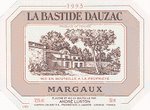
I don't think there has been a year when I have bought more lottery tickets than this year. The "megamillions" game prize has soared a couple of times, and I have been tempted to buy a few tickets. Thinking rationally, I know that I do not have the smallest chance of ever winning, but five dollars buys a little dream. I dream about helping people out, having the luxury of not having to work, traveling more, and all the other things that most people dream about. As for my wine life, when I fantasize about winning the lottery, sometimes I think that the quality of my wine life would actually go down if I won lots of money. I am lucky enough to drink a wonderful wine at least once a week, and, if I am lucky, it can be even more often than that. The real pleasure, though, seems to come from finding those hidden bargains -- the wines that nobody else has discovered. If I won the lottery and could afford to drink Chateau Mouton every single night, the pleasure of the hunt for that wonderful undervalued wine would evaporate with the money.
Seeking out underpriced wines involves some specific techniques that many underpaid and overworked wine lovers know about, and I thought it might be useful to document a few of them here -- I will get to my comments on La Bastide de Dauzac in a second.
1. Undervalued Grapes
The most expensive wines from California tend to be based on Cabernet Sauvignon for reds or Chardonnay for whites. Avoiding these grapes, you can find some wonderful bargains. For example, several wineries make wines based on Sauvignon Blanc, and this can give you access to the work of some of California's top producers. Try the Sauvignon Blanc from Ferrari Carano, for example. Other Sauvignon Blancs include Groth, and others. Other frequently undervalued grapes include Chenin Blanc, Zinfandel, Viognier, Tempranillo, Petite Syrah, and Grenache. How about the Chenin Blanc from Dry Creek Vineyard or the Petite Syrah from Bogle?
2. Up-and-coming areas
When you buy from the world's most highly prized appellations, you can expect to pay top prices for your wines. These areas include Napa, Bordeaux, Burgundy, Tuscany, and a few others. Jancis Robinson made an interesting remark in one of her books when she bought a piece of property in the Languedoc -- she actually bought there to get away from the world of work. Within a few years, the Languedoc emerged as one of the most exciting places that produces wine in the world! So much for her desire to escape!
I have picked up treasures from New Zealand, Spain, South Africa, Argentina, Lodi, and Washington state. There are, of course, many other bargain areas, and it is fun to discover them before the rest of the world does.
3. Off Years
You have to be careful here, but I have had some marvellous wines from the very top producers at wonderful prices. For example, a couple of years ago, there was a 1987 Cos d'Estournel on the wine list of an excellent restaurant (Russells in Bloomsburg, PA). The restaurant keeps their wine well, and the wine turned out to be delicious.
I have tasted a first growth Bordeaux only twice -- once, I bought a 1987 Chateau Lafite from the duty free shop on the border between Canada and the United States, and I also once had a bottle of 1984 Chateau Latour. I would not have missed these opportunities for the world. (Both 1984 and 1987 were off years in an otherwise wonderful decade in Bordeaux.)
4. Second Labels
Top wineries sometimes have a second label. They often do this to make sure that when you buy Chateau Lafite, for example, you really are getting a top-quality product. So they make a second label called Carruades de Lafite, which is often excellent wine. It is like being a dog eating some of the scraps thrown from the king's table!
This technique works especially well for Bordeaux wines. Often you get "almost the real thing" for a fraction of the price. My successes in this pursuit include drinking Les Forts de Latour, the second label of Chateau Latour, Sarget de Gruaud (Gruaud Larose), Le Pavillon Rouge (Margaux), Petit Cheval (Cheval Blanc), and Bahans Haut Brion (Haut Brion). Many of the big names in Bordeaux have second labels -- check them out.
La Bastide de Dauzac is the second label of Chateau Dauzac.
5. Treasure Hunting
Just occasionally, you find a bottle that has somehow found its way into a shop where wine lovers rarely go. Tucked away in a corner, there is a bottle of something really special. It is a few years old, but lying on its side, and extremely low. (I once got a bottle of Chateau Nairac, 1983, for less than $10!) But these occasions are like winning the lottery!
Now, back to the subject of this post, La Bastide de Dauzac, 1997, which is Chateau Dauzac's second label. Chateau Dauzac is a fifth growth Bordeaux in Margaux. It is planted with 58% Cabernet Sauvignon, 37% Merlot, and 5% Cabernet Franc. In a Margaux, you hope to find elegance, balance, and finesse with perhaps less power or concentration than some people like.
Perhaps the moral of this story is that you should not try to apply more than one of these techniques at a time. After all, La Bastide is a second label, and 1997 was not a very good year for Bordeaux. The wine was a horrid, mean little wine. It tasted weedy and stalky -- a little bit astringent. It was still tannic, but it did not have any of the fresh fruit that you get in a younger wine.
It was not off, but it just was not a very nice wine. A real disappointment!
This blog continues on http://www.louisandlouisa.com
No comments:
Post a Comment